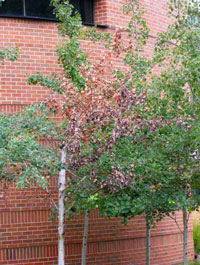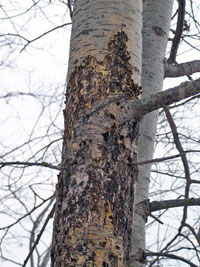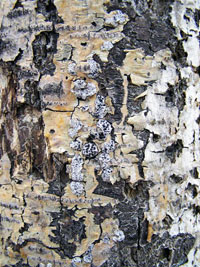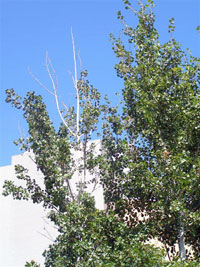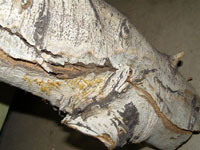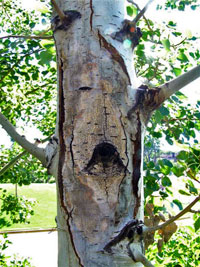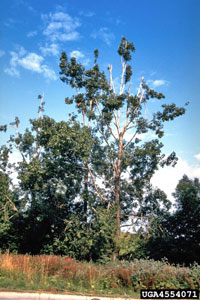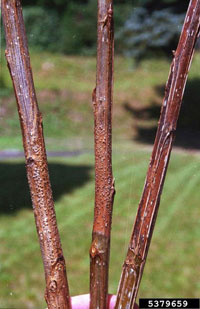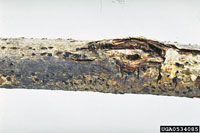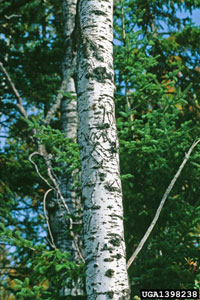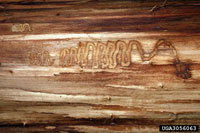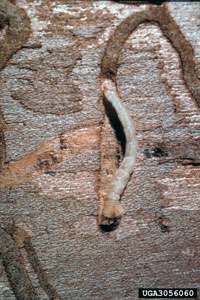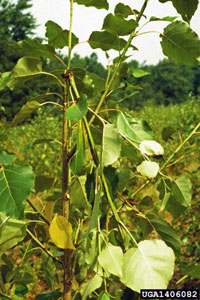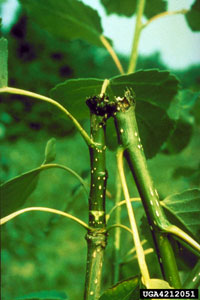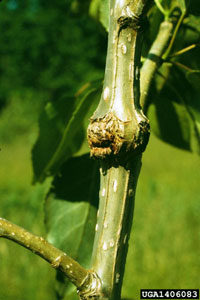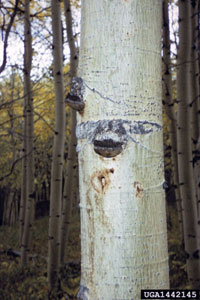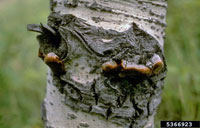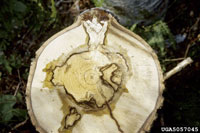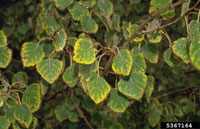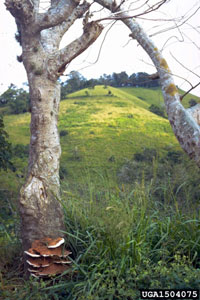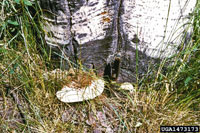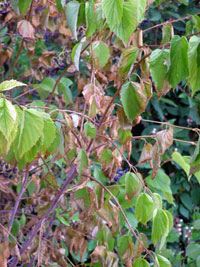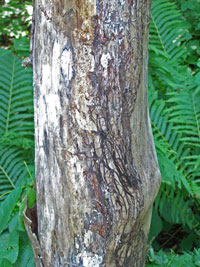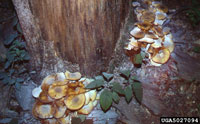Extension > Garden > Diagnose a problem > What's wrong with my plant? > Deciduous Trees > Poplar > Scattered dead branches in canopy
Poplar > Trunk/Branches > Scattered dead branches in canopy
1 of 9
Hypoxylon canker
Entoleuca mammata
- Leaves on one or more branches are undersized, turn yellow then to brown and remain attached to stem
- Cankers begin near wounds or at the base of a branch
- Infected bark initially turns yellowish-orange; older infections are black at center with yellowish-orange margins
- Bark first appears blistered and raised, then falls off to reveal blackened wood
- Clusters of raised buff white to black bump like fungal stromata can be seen on 3 year old cankers
- Damage most common on trembling aspen
- More information on Hypoxylon canker
2 of 9
Valsa and Leucostoma cankers
Valsa sordida and Leucostoma niveum
- Random dead branches seen throughout canopy
- Sunken irregularly-elongated cankers with cracked bark at the edges occur on branches or the main trunk
- Leaves on random branches wilt, turn yellow then brown
- Cankers are brown to black at the center with salmon to orange discoloration of the bark at the edges
- In wet weather curled tendrils of orange spores emerge from pimple like fungal structures within infected branches
- Common on trees stressed by drought, winter injury, wounds, insect feeding or other factors
- More information on canker
3 of 9
Cryptodiaporthe canker
Cryptodiaporthe populea
- Random dead branches caused from girdling cankers seen throughout canopy
- Bark on cankers may or may not be discolored, but the tissue beneath the bark will be brown to black
- Leaves on infected branches turn yellow and drop prematurely
- Multiple thin weak adventitious shoots develop
- Callus tissue formed around edges of cankers causing bark to fall off and expose the wood beneath it
- Common on Lombardy poplars
4 of 9
Bronze poplar borer
Agrilus granulatus
- Branch die back and death caused by larvae feeding under bark
- Creates serpentine S-shaped galleries underneath bark
- "D" shaped exit holes present in affected branches
- Adults have black bodies with a tinge of metallic green; approximately 3/8th inch long
- Larvae are whitish, slender, 1- 1 ½ inch long with 2 dark brown tail-like structures at the end of the body
- More information on Bronze poplar borer
5 of 9
Poplar-gall saperda
Saperda inornata
- Branch tips die and/or break over above the gall
- Twig bulges or becomes round where longhorned beetle larvae are feeding
- Fully grown larvae are up to 1" long, creamy-white and legless
- Common on quaking aspen
- More information on Poplar-gall saperda
6 of 9
Trunk and limb rot
Phellinus tremulae
- The canopy may show no symptoms or may have small yellowing leaves/dead branches depending on the extent of the trunk decay
- In cross section of the trunk, the wood at the center is discolored, soft, crumbling, stringy or spongy
- Fungal fruiting bodies arise along the stem, near a pruning wound, crack or other wound
- Fruiting bodies are up to 8 inches wide to 6 inches thick; lower surface at 45 degree angle
- Fungal surface is pale brown when young to black and crusted when aged
- More information on Trunk and limb rot
7 of 9
Deicing salt injury
- Run-off salt kills roots which results in die-back of branches
- Soil salt damage causes leaf edges or margins to appear burnt or scorched progressing toward the mid-vein
- Affected trees leaf out later than other non-infected trees
- Damage most noticeable in spring and the summer growing season
- More information on Deicing salts
8 of 9
Ganoderma root and butt rot
(aka. artist's conk)
Ganoderma applanatum
- Leaves are smaller in size and turn yellow earlier than normal
- Canopy appears thin with few leaves and multiple dead branches
- Fungal conks, a semicircle shelf fungi, can be found from the base of the tree up to 3 feet high on the trunk
- Conks are reddish brown and shiny on top, white and porous underneath, a rim of white may be visible on the edge of
growing conks - Infected wood at tree base is white, soft, stringy or spongy
- Infected trees frequently break or fall over in storms
- More information on Ganoderma butt rot
9 of 9
Armillaria root rot
Armillaria spp.
- Infected trees have poor growth, dead branches in the upper canopy, undersized and/or yellow leaves
- Flat white sheets of fungal growth (mycelia fans) grow between the bark and sapwood at the base of infected trees
- Thick black, shoestring-like fungus can sometimes be seen under the bark, around roots and in the soil around the base of the tree
- Wood is decayed, white, soft and spongy, and this may extend from the base of the tree well up into the trunk
- Clusters of honey-colored mushrooms may grow at the base of the tree in fall
- More information on Armillaria root rot



